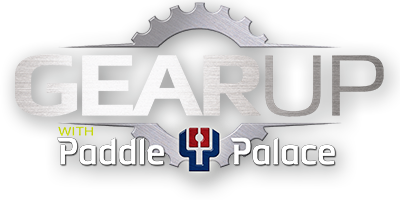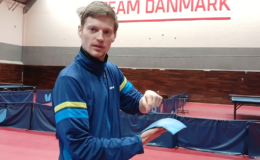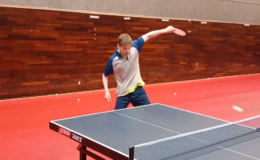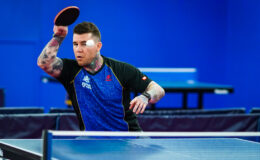By Larry Hodges, USATT Hall of Famer and Certified National Coach
Table Tennis is an Olympic Sport, and at the highest levels, is played by some of the best athletes on the planet. Even at levels below world class it is dominated by great physical athletes who can race about the court ripping shot after shot. But we’re not all great physical athletes, and we’re not about to give up against an opponent just because he can race around the court ripping shot after shot, and we can’t, are we? So how can one compete with an opponent who is faster, stronger, and more athletic? Or against a kid who might not be bigger and stronger, but who can seemingly rally at ten times your pace?
To do so you need to think both strategically and tactically. Strategically, you need to develop the tools needed to defeat these physical phenoms. Tactically, you need to learn how to use those tools. So what are these tools, and how can you use them? There are a number of ways of defeating a more athletic opponent. Here are ten tools you can develop in your game to turn an Arnold Schwarzenegger into a 90-pound weakling and kick ping-pong sand in their face.
- Serves, serves, and serves. This could be the first three items. You have complete control over the start of the rally when serving, and this is where great athletes can be turned into quivering masses of mishits. A book could be written on this topic alone. Suffice to say that you should use serves to set up your best shot, and to set up the other tools outlined below. Mix in short and long serves, with extreme and varying spins. Often the best tactics is to mix in short serves to the forehand and long, breaking spin serves to the backhand. Or just serve short backspin (and no-spin) and loop first.
- Receive, receive, and receive. This could be the next three items. Above I said that the server has complete control over the start of the rally. The key word there is “start,” and if you develop strong receive, you take control. You don’t want to take on a faster opponent in a speed battle by attacking all his serves. Instead, focus on variation and control. Use your receive just as you used your serve, to set up your best shot, and to set up the other tools outlined below. The key difference is that you can use these tools as your receive, and set the tone for the rally.
- Spin. Table tennis is a game of spin, and you should use the extremes to mess up your athletic opponent. Use both heavy topspin and heavy backspin so that he has to make major adjustments. Heavy, deep backspins slow the pace down; even if your athletic opponent attacks it, it’ll likely be a slower shot that you can block or counter-attack aggressively. If you topspin, focus on slow, spinny loops that go deep on the table, and watch your opponent struggle to deal with these. He’s probably used to something faster; don’t give it to him. So look to push heavy or loop very spinny, both deep on the table. (I could have broken this down into Backspin and Topspin, but I really believe they go together in this context.)
- Deep. If the ball is deep, your opponent can’t rush you, and he’s often jammed. A steady player can out-rally a faster, stronger one as long as he keeps the ball deep. So practice rallying deep on the table, both in topspin and backspin rallies.
- Short. If you can push a ball short and low, it’ll tie up your opponent over the table, leaving him vulnerable to a follow-up deep shot. It’ll also take most of his attack away.
- Vary Pace and Depth. While keeping the ball deep is important in most rallies, mix in softer and shorter shots to mess up an opponent’s timing. Great athleticism doesn’t mean great timing, and moving an opponent in and out can make an athlete look like he’s been snake-bit.
- Move the Ball Around. Focus on the three spots – wide backhand, wide forehand, and middle (roughly the opponent’s playing elbow, his crossover shot between forehand and backhand). If your opponent is mostly a forehand player, play the corners. (Yes, go to his wide forehand so you can draw him out of position and come back to his backhand, plus he’s often looking for forehands from the backhand side, and so shots to the forehand can be hard for him to handle well.) If he’s more two-winged, then go after his middle to draw him out of position, and then go after the corners.
- Deceptive Placement. Aim one way, then go the other. This is especially effective when pushing or blocking. The most common way is to aim a backhand push or block crosscourt, and at the last second go to the wide forehand.
- Out-Rally Him. Don’t take on a faster opponent in a speed battle. Instead, take the ball a little later to give yourself time to react, and play steady and deep rallies until the opponent either misses or gives you a ball to attack. Often it’s effective to start the rally off with one quick shot, and then play steady – the contrast can throw off the faster opponent’s timing. Against some players you can just pin down on their weaker side (usually the backhand) and play deep balls there over and over until they miss (though you should look for chances to move the ball around or change the pace or spin). Against others you need to keep moving the ball around so the opponent is forced to hit shots on the move.
- Stay Focused and Play Smart. It’s often said that table tennis is 90% mental. Let your opponent have the other 10%; just make sure you win the 90% mental battle.



